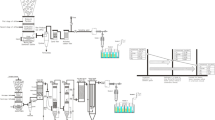Abstract
Landfill gas (LFG) utilization which means a synergy between environmental protection and bioenergy recovery was investigated in this study. Pressure swing adsorption technology was used in LFG purification, and laboratory experiment, pilot-scale test, and on-site demonstration were carried out in Shenzhen, China. In the laboratory experiment, A-type carbon molecular sieve was selected as the adsorbent by comparison of several other adsorbents. The optimal adsorption pressure and adsorption time were 0.25 MPa and 2 min, respectively, under which the product generation rate was 4.5 m3/h and the methane concentration was above 90%. The process and optimization of the pilot-scale test were also reported in the paper. The product gas was of high quality compared with the National Standard of Compressed Natural Gas as Vehicle Fuel (GB18047-2000), when the air concentration in feed gas was under 10.96%. The demonstration project was composed of a collection system, production system, and utilization system. The drive performance, environmental protection performance, and economic feasibility of the product gas — as alternative fuel in passenger car, truck, and bulldozer—were tested, showing the feasibility technology for LFG utilization.
Similar content being viewed by others
References
IPCC. Climate change 2001: The scientific basis. In: Houghton J T, Ding Y, Griggs D J, Noguer M, van der Linden P J, Dai X, Maskell K, Johnson C A, eds. Contribution of Working Group I to the Third Assessment Report of the Intergovernmental Panel on Climate Change. Cambridge and New York: Cambridge University Press, 2001, 101
IPCC. Summary for policymakers. In: Metz B, Davidson O R, Bosch P R, Dave R, Meyer L A, eds. Climate Change 2007: Mitigation, Contribution of Working Group III to the Fourth Assessment Report of the Intergovernmental Panel on Climate Change. Cambridge and New York: Cambridge University Press, 2007, 3
IPCC. Climate change 1995. In: Houghton J T, Meira Filho L G, Callander B A, Harris N, Kattenberg A, Maskell K, eds. The Science of Climate Change, Published for the Intergovernmental Panel on Climate Change, World Meteorological Organization/United Nations Environment Programme. Cambridge and New York: Cambridge University Press, 1996, 257
Park J W, Shin H C. Surface emission of landfill gas from solid waste landfill. Atmospheric Environment, 2001, 35(20): 3445–3451
Adrian K M, Mostafa A W, Rodrigo D. Modeling greenhouse gas emissions for municipal solid waste management strategies in Ottawa, Ontario, Canada. Resources, Conservation and Recycling, 2008, 52(11): 1241–1251
Lombardi L, Carnevale E, Corti A. Greenhouse effect reduction and energy recovery from waste landfill. Energy, 2006, 31: 3208–3219
Themelis N J, Ulloa P A. Methane generation in landfills. Renewable Energy, 2007, 32: 1243–1257
National Bureau of Statistics of China. China Statistical Yearbook 2008. Beijing: Chinese Statistics Press, 2008 (in Chinese)
Hao X L, Yang H X, Zhang G Q. Trigeneration: A new way for landfill gas utilization and its feasibility in Hong Kong. Energy Policy, 2008, 36: 3662–3673
Lee C E, Hwang C H, Lee H Y. A study on the interchangeability of LFG-LPG mixed fuels with LFG quality in domestic combustion appliances. Fuel, 2008, 87(3): 297–303
Tsai W T. Bioenergy from landfill gas (LFG) in Taiwan. Renewable and Sustainable Energy Reviews, 2007, 11: 331–344
Shin H C, Park J W, Kim H S, Shin E S. Environmental and economic assessment of landfill gas electricity generation in Korea using LEAP model. Energy Policy, 2005, 33: 1261–1270
Bove R, Lunghi P. Electric power generation from LFG using traditional and innovative technologies. Energy Conversion Management, 2006, 47: 1391–1401
Shi L, Zhao Y C, Niu D J. Technique progress in landfill gas purification. Natural Gas Chemical Industry, 2004, 29: 58–62 (in Chinese)
Liu M E, Chen H L. New Separation Technology Foundation. 2nd ed. Hangzhou: Zhejiang University Press, 1993, 1–15 (in Chinese)
Liang G L. A perspective on the adsorbent and catalyst for gas separation in China. Low Temperature and Specialty Gases, 1996, 1: 1–4 (in Chinese)
Author information
Authors and Affiliations
Corresponding author
Rights and permissions
About this article
Cite this article
Wang, W., Luo, Y. & Deng, Z. Bioenergy recovery from landfill gas: A case study in China. Front. Environ. Sci. Eng. China 3, 20–31 (2009). https://doi.org/10.1007/s11783-009-0012-9
Received:
Accepted:
Published:
Issue Date:
DOI: https://doi.org/10.1007/s11783-009-0012-9




